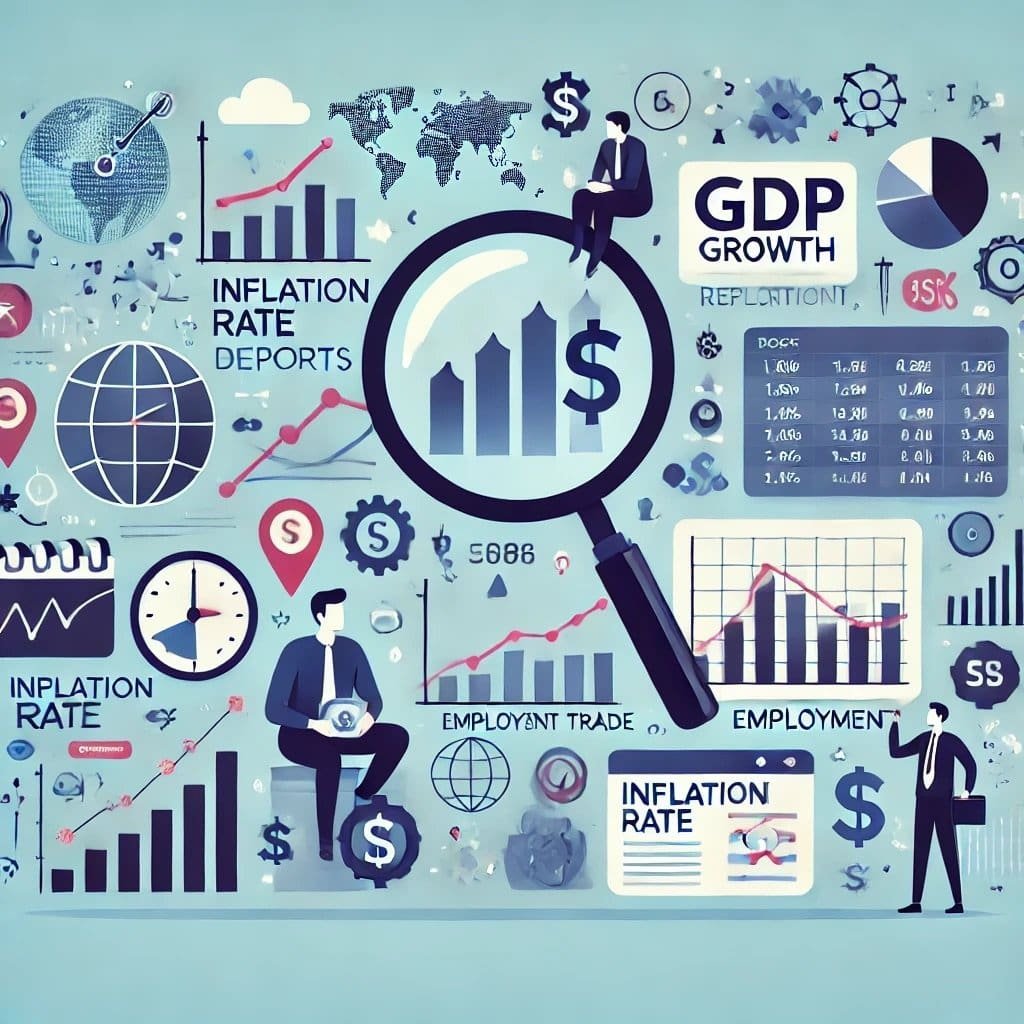Economic indicators are essential tools for understanding the health and direction of an economy. These indicators—such as GDP, inflation, and employment reports—offer valuable insights for investors, businesses, and policymakers. Interpreting these reports correctly can help you make informed financial decisions and adjust your investment strategies accordingly.
Key Economic Indicators
1. Gross Domestic Product (GDP)
• What it is: GDP measures the total value of goods and services produced in a country over a specific period, usually quarterly or annually. It’s one of the most comprehensive indicators of economic activity and growth.
• How to interpret: A rising GDP suggests economic growth, which is often associated with increased corporate earnings and investment opportunities. Conversely, a declining GDP may signal an economic slowdown or recession.
• Real GDP: Adjusted for inflation, Real GDP provides a clearer picture of actual growth by accounting for the effects of price changes.
2. Inflation Rate
• What it is: Inflation measures the rate at which the prices of goods and services rise over time. Common measures include the Consumer Price Index (CPI) and Producer Price Index (PPI).
• How to interpret: Moderate inflation (around 2-3%) is normal in a growing economy. However, high inflation erodes purchasing power, reduces consumer spending, and can negatively impact businesses. On the other hand, deflation (falling prices) can signal economic weakness.
• CPI vs. PPI: CPI measures inflation from the consumer’s perspective, while PPI tracks price changes from the producer’s viewpoint. Both provide insights into price trends in the economy.
3. Unemployment Rate
• What it is: The unemployment rate represents the percentage of the labor force that is actively seeking employment but unable to find work. It is a critical indicator of labor market health.
• How to interpret: A low unemployment rate indicates a strong labor market, often leading to higher consumer spending and economic growth. However, very low unemployment can also result in wage inflation. High unemployment suggests economic weakness and may signal a recession.
• Nonfarm Payrolls: This report, released monthly in the U.S., provides insight into job creation across various sectors (excluding farming). It’s closely watched by investors and economists.
4. Interest Rates
• What it is: Central banks, like the Federal Reserve, set benchmark interest rates to control monetary policy. The most common rates include the federal funds rate (in the U.S.) or the base rate (in other countries).
• How to interpret: Lower interest rates encourage borrowing and spending, stimulating economic growth. Conversely, higher rates slow borrowing and reduce inflationary pressures. Investors watch rate changes closely, as they affect stock and bond markets, as well as consumer loans like mortgages.
5. Trade Balance
• What it is: The trade balance measures the difference between a country’s exports and imports. A trade surplus occurs when exports exceed imports, while a trade deficit means the opposite.
• How to interpret: A trade surplus can indicate a competitive economy, whereas a large trade deficit may signal an overreliance on foreign goods and capital outflows. Persistent trade deficits can affect currency values and economic stability.
6. Retail Sales
• What it is: This indicator tracks consumer spending on goods and services, often serving as a proxy for consumer confidence.
• How to interpret: Strong retail sales indicate healthy consumer demand, which drives economic growth. Weak retail sales may signal economic uncertainty or reduced consumer confidence.
7. Housing Starts and Building Permits
• What it is: Housing starts represent the number of new residential construction projects, while building permits track the approval of future construction projects.
• How to interpret: Both are leading indicators of economic activity in the construction and real estate markets. A rise in housing starts suggests future economic growth, as construction drives jobs and demand for materials.
Understanding Economic Reports in Context
1. Leading vs. Lagging Indicators
• Leading Indicators: These indicators, such as building permits or consumer confidence, signal the future direction of the economy. Investors use leading indicators to anticipate changes in market conditions.
• Lagging Indicators: These, such as unemployment rates or corporate earnings, confirm past economic performance. While they don’t predict future trends, they provide a reliable assessment of where the economy has been.
2. Seasonal Adjustments
• Many economic reports are seasonally adjusted to account for fluctuations that occur at specific times of the year, such as holiday spending or agricultural cycles. Understanding whether data is seasonally adjusted helps you get a clearer picture of underlying trends.
3. Relative Importance
• Not all indicators are equally important at all times. For example, during times of inflationary pressure, inflation rates and central bank interest rate decisions take precedence. In periods of economic recovery, job creation and GDP growth are key.
How Economic Indicators Impact Investments
1. Stock Market
• Investors often react to economic data releases, as these reports provide insights into corporate profitability and consumer behavior. Strong GDP growth or employment data typically boosts investor confidence, leading to stock market gains. Conversely, weak economic reports may cause stocks to decline as investors worry about corporate earnings and economic health.
2. Bonds
• Bond prices are highly sensitive to interest rates and inflation. Rising interest rates generally lead to falling bond prices, as newer bonds offer better returns. Inflation also erodes the real return on bonds, making inflation data critical for bond investors.
3. Currencies
• Economic reports affect currency values, especially when they signal changes in interest rates or trade balances. Strong economic growth often leads to a stronger currency, while weak economic performance or large trade deficits can weaken it.
Conclusion
Understanding and interpreting economic indicators and reports is crucial for making informed financial decisions. Whether you’re investing in the stock market, bonds, or real estate, staying informed about the state of the economy can help you adjust your strategy to capitalize on opportunities or mitigate risks. By following key indicators like GDP, inflation, and unemployment, you’ll gain a deeper insight into the broader economic landscape and its potential impact on your financial goals.


